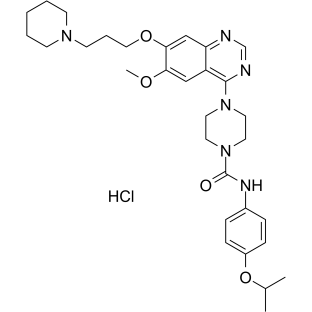Tandutinib hydrochloride (Synonyms: MLN518 hydrochloride; CT53518 hydrochloride) |
| Catalog No.GC38853 |
Tandutinib hydrochloride (MLN518 hydrochloride) is a potent and selective inhibitor of the FLT3 with an IC50 of 0.22 μM, and also inhibits c-Kit and PDGFR with IC50s of 0.17 μM and 0.20 μM, respectively. Tandutinib hydrochloride can be used for acute myelogenous leukemia (AML). Tandutinib hydrochloride has the ability to cross the blood-brain barrier.
Products are for research use only. Not for human use. We do not sell to patients.

Cas No.: 2438900-70-8
Sample solution is provided at 25 µL, 10mM.
Tandutinib hydrochloride (MLN518 hydrochloride) is a potent and selective inhibitor of the FLT3 with an IC50 of 0.22 μM, and also inhibits c-Kit and PDGFR with IC50s of 0.17 μM and 0.20 μM, respectively. Tandutinib hydrochloride can be used to treat acute myelogenous leukemia (AML)[1][2]. Tandutinib hydrochloride has the ability to cross the blood-brain barrier[3].
Tandutinib (0-3 μM; 30 minutes; Ba/F3 cells) treatment inhibits IL-3-independent cell growth and FLT3-ITD autophosphorylation with an IC50 of 10-100 nM in Ba/F3 cells expressing different FLT3-ITD mutants[1].Tandutinib (1 μM; 24-96 hours; Molm-14 and THP-1 AML cells) treatment induces apoptosis in FLT3-ITD-positive AML cells[1].In human FLT3-ITD-positive AML cell lines, Tandutinib inhibits FLT3-ITD phosphorylation (IC50 of ~30 nM). As with Erk2, a constitutively high level of Akt phosphorylation is readily detected and is efficiently blocked by pretreatment of the Molm-14 cells with 100-300 nM Tandutinib[1].Tandutinib inhibits cell proliferation of the FLT3-ITD-positive Molm-13 and Molm-14 with an IC50 of 10 nM. And signaling through the MAP kinase and PI3 kinase pathways[1]. Apoptosis Analysis[1] Cell Line: Molm-14 and THP-1 AML cells
Tandutinib (60 mg/kg; oral gavage; daily; for 35 days; athymic nude mice) treatment causes a statistically significant increase in survival that was extended on average by 20 days[1]. Animal Model: Athymic nude mice injected with Ba/F3 cells[1]
[1]. Kelly LM, et al. CT53518, a novel selective FLT3 antagonist for the treatment of acute myelogenous leukemia (AML). Cancer Cell. 2002 Jun;1(5):421-32. [2]. Griswold IJ, et al. Effects of MLN518, a dual FLT3 and KIT inhibitor, on normal and malignant hematopoiesis. Blood. 2004 Nov 1;104(9):2912-8. [3]. Yang JJ, et al. P-glycoprotein and breast cancer resistance protein affect disposition of tandutinib, a tyrosine kinase inhibitor. Drug Metab Lett. 2010 Dec;4(4):201-12.
Average Rating: 5 (Based on Reviews and 39 reference(s) in Google Scholar.)
GLPBIO products are for RESEARCH USE ONLY. Please make sure your review or question is research based.
Required fields are marked with *




















